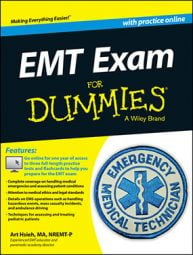The EMT exam has two portions. In addition to your cognitive exam (taken on a computer), you need to successfully complete a hands-on practical (or psychomotor) skills examination, usually in the form of a final practical exam at the end of your course. Your state EMS office determines the exact skills that are tested; your instructor will tell you what will be evaluated.
Here are a few pointers for succeeding on your practical exam, no matter what’s covered:
Know which skills you’ll be tested on early; if possible, find out from the instructor at the beginning of the course.
Practice early and often. Many of the skills an EMT performs aren’t intuitive or simple; skills such as splinting or spinal immobilization have many steps. Your brain memorizes facts and figures to help with answering written questions; your body memorizes each physical movement of a skill in order to put it together in a fluid motion.
Practice with friends. Having a classmate watch you perform a skill provides you with better feedback on how well you performed. Make sure your classmate has a skill sheet to look at while you perform and check off what you did and didn't do correctly.
As you get better at a skill, test yourself under the same conditions as the actual test. For example, there may be a time limit to the skill — use the same limit as you perform your final practice runs to make sure you can get it done in time.

